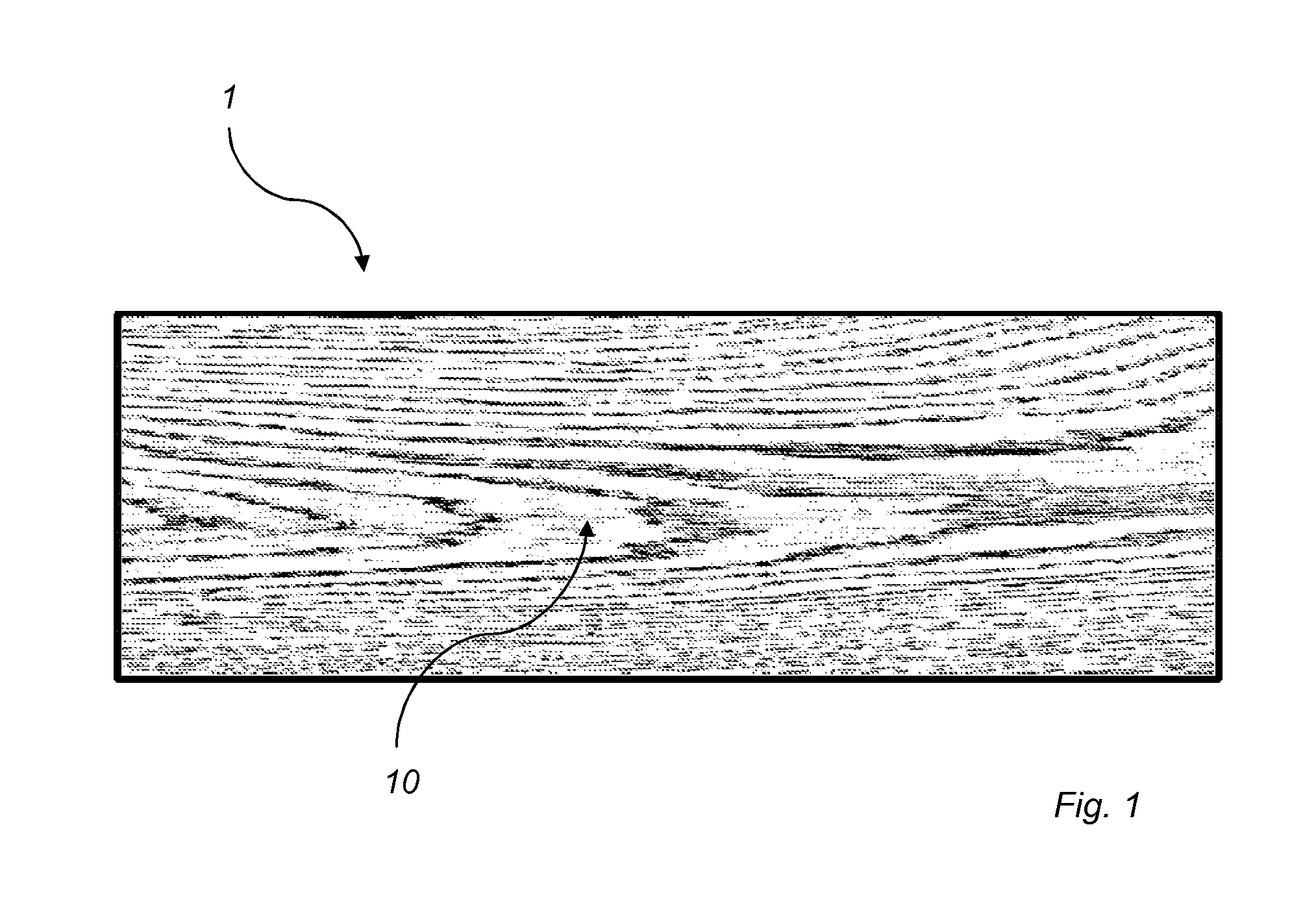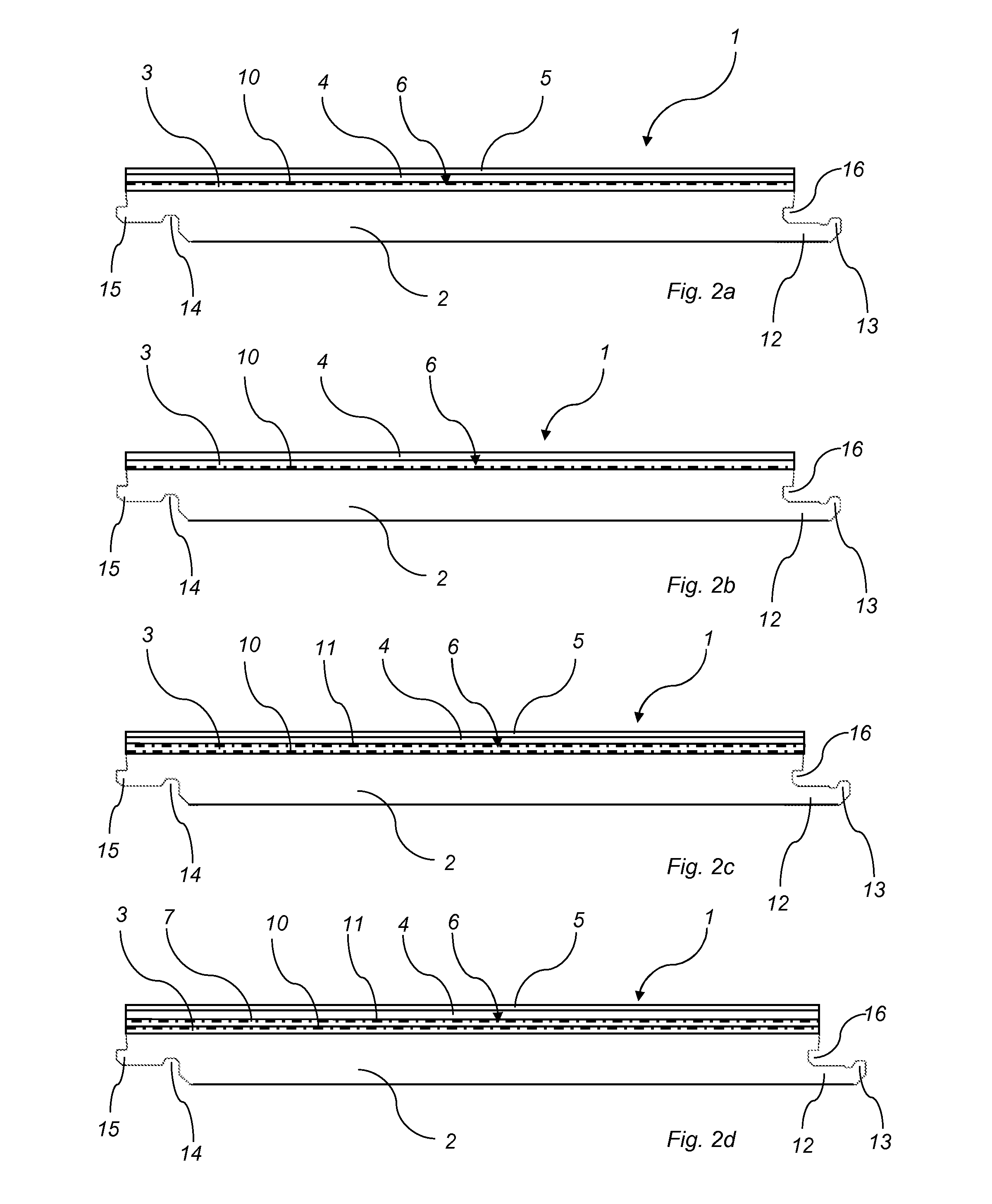Method of producing a building panel
a building panel and production method technology, applied in the direction of lamination, lamination auxiliary operations, lamination, etc., can solve the problems of difficult printing with aqueous ink on a thermoplastic surface, certain repetition of patterns cannot be avoided by rotogravure printing or direct printing, and achieve the effect of facilitating wetting of the surface, reducing the difficulty of wettability of the surface, and reducing the difficulty of wettability
- Summary
- Abstract
- Description
- Claims
- Application Information
AI Technical Summary
Benefits of technology
Problems solved by technology
Method used
Image
Examples
example 1
[0151]A white, PVC foil for LVT was treated with a primer comprising 30 g / 100 ml of NaCl dissolved in deionized water, corresponding to 84% of the saturation point for NaCl in water. The foil was dried before further steps. The contact angle of the primer on the PVC foil was measured to about 90°.
[0152]The foil treated with the primer was printed by means of a digital printer with a water based ink . The print was dried in 60° C. during 10 min. The printed foil was bonded to a transparent protective foil of PVC for LVT in a hot / cold-pressing step at 185° C. for 70 seconds at approximately 6 bar pressure, followed by cooling down to 25° C. at approximately 5 bar pressure. The bonding between the printed PVC foil and the protective foil was good.
[0153]It was not possible to apply the primer evenly over the surface of the foil due to the difference in surface tension between the primer and the LVT-foil. The printed image is not fixated evenly due to the poor application of the primer.
example 2
[0154]A white, PVC foil for LVT was treated with a primer comprising 30 g / 100 ml of NaCl dissolved in deionized water, corresponding to 84% of the saturation point for NaCl in water. 2.0 weight-% of BYK 345 as a wetting agent was added to the primer solution. The contact angle of the primer on the PVC foil was measured as less than 40°. The foil was dried before further steps.
[0155]The foil treated with the primer was printed by means of a digital printer with a water based ink. The print was dried in 60° C. during 10 min. The printed foil was bonded to a transparent protective foil of PVC for LVT in a hot / cold-pressing step at 185° C. for 70 seconds at approximately 6 bar pressure, followed by cooling down to 25° C. at approximately 5 bar pressure. The bonding between the printed PVC foil and the protective foil was good.
[0156]The primer was evenly applied over the surface on the LVT-foil. The printed image was not fixated evenly due to insufficient concentration of NaCl in the pri...
example 3
[0157]A white, PVC foil for LVT was treated with a primer comprising 35 g / 100 ml of NaCl dissolved in deionized water, corresponding to 97% of the saturation point for NaCl in water. 2.0 weight-% of BYK 345 as a wetting agent was added to the primer solution. The contact angle of the primer on the PVC foil was measured as less than 40°. The foil was dried before further steps.
[0158]The foil treated with the primer was printed by means of a digital printer with a water based ink. The print was dried in 60° C. during 10 min. The printed foil was bonded to a transparent protective foil of PVC for LVT in a hot / cold-pressing step at 185° C. for 70 seconds at approximately 6 bar pressure, followed by cooling down to 25° C. at approximately 5 bar pressure. The bonding between the printed PVC foil and the protective foil was good.
[0159]The primer is evenly applied over the surface on the LVT-foil. The printed image is fixated evenly over the surface of the foil and a print result with good ...
PUM
| Property | Measurement | Unit |
|---|---|---|
| temperature | aaaaa | aaaaa |
| contact angle | aaaaa | aaaaa |
| contact angle | aaaaa | aaaaa |
Abstract
Description
Claims
Application Information
 Login to View More
Login to View More - R&D
- Intellectual Property
- Life Sciences
- Materials
- Tech Scout
- Unparalleled Data Quality
- Higher Quality Content
- 60% Fewer Hallucinations
Browse by: Latest US Patents, China's latest patents, Technical Efficacy Thesaurus, Application Domain, Technology Topic, Popular Technical Reports.
© 2025 PatSnap. All rights reserved.Legal|Privacy policy|Modern Slavery Act Transparency Statement|Sitemap|About US| Contact US: help@patsnap.com



